German mini-subs and human torpedoes
WW2 U-Boats:
Seeteufel (1944) | Type Ia U-Boats (1936) | Type II U-Boats (1935) | Type IX U-Boats (1936) | Type VII (generic) | VIIA | VIIB | VIIC | VIIC/41 | VIIC/42 | VIID | VIIF | Type XB U-Boats (1941) | Type XIV U-Boats (1941) | Type XVII U-Boats (1944) | Type XXI U-Boats (1944) | Type XXIII U-Boats (1944) | German mini-subs and human torpedoesIntroduction: K-verband projects:
Not a part of the series of famous “V-weapons”, these ultra-modern miracle weapons supposed to reverse the fate of the Reich, these very light units of the Kriegsmarine appeared late, as a last-ditch naval bulwark to the enormous means deployed by the allies. With the massive intensification of anti-submarine warfare in the Atlantic, the efficiency of classical U-Bootes – particularly those of type VII – was diminishing while seeing the losses increasing, at a point of rupture.
Classical U-boote operations shown their limitations. Costly in men, oil and raw materials, large U-boats were no longer efficient.
The general staff was beginning to think of a massive production of lightweight units, much more economical, in particular to meet well-localized objectives. These units were produced by the hundreds (in total more than 1200), and two main types could be distinguished: “Pocket subs” commonly called midget submersibles, and human torpedoes.
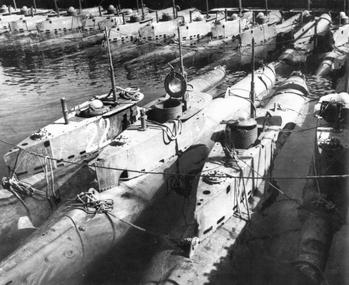
A serie of Seehunds – perhaps the best midget submarine of the war.
German Midget Submersibles:
Four types of “Kleine Unterseeboote” (KU) saw successively the day. They were characterized by a crew of one or two men, a classic or torpedoid hull, an electric or mixed gasoline propulsion, two torpedoes, built in prefabricated sections. Their handling was in principle easy and their hull was pressurized. They were not “disposable weapons” but rather reusable submersibles. Relatively light, they could be transported by rail to see by air, and thus operate from many defense zones including large rivers. In operations, however, they were rather disappointing.
Molch:
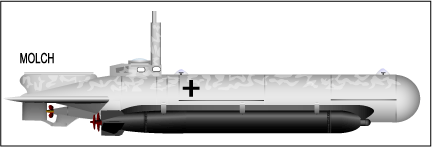
The “Salamanders” were the first German pocket submersibles in use. They were inspired by torpedo technology and had a cylindrical hull, housing a huge Nickel-Cadmium battery. The latter gave them a great submerged autonomy, but a radius of action of only 40 nautical miles at 5 knots. The pilot was sitting behind the battery, between the two ballast tanks. In coastal use, submerged and silent, they were dedicated to special operations against allied landings. The first copy was only operational in June 1944, delivered by AG Weser in Bremen. In the south of France, 12 units entered operation during the desperate attempt of the flotilla K-Werband 411 to oppose the landing in Provence (operation Anvil-Dragoon).
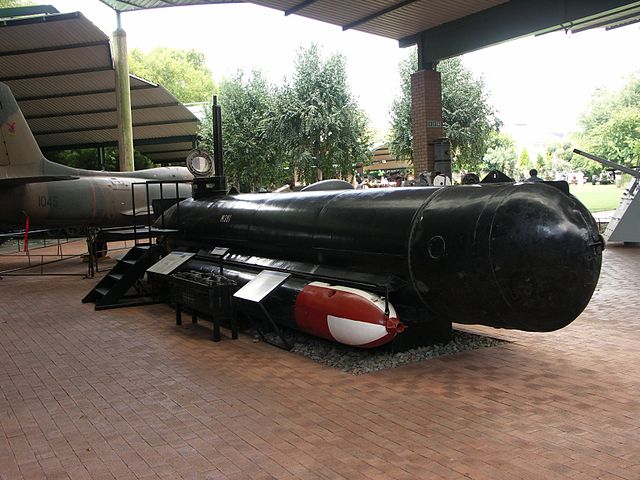
The failure was total, with the loss of 10 units out of the 12, the other two being later destroyed by a bombardment of San Remo. Deployed in Holland, notably in Antwerp, other Molch attempted unsuccessfully to threaten the Allied transports. There were a total of 107 sorties until March 1945, with no notable success and most of the 393 Molch built went to training, an aspect previously neglected by Kriegsmarine cadres for this type of unit and which Would produce such low results.
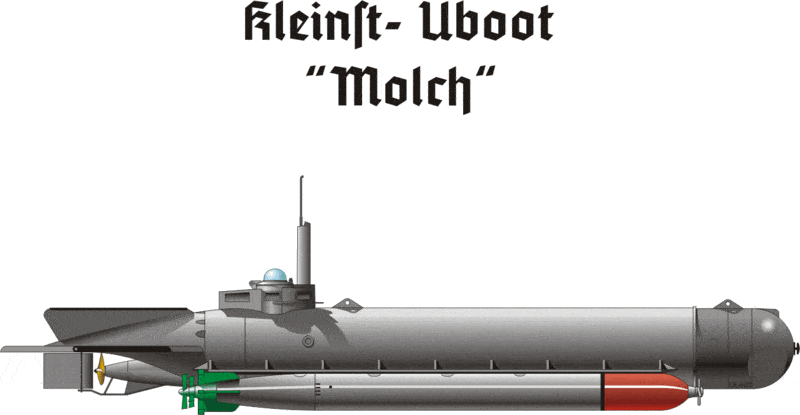
Specs
-Dimensions 10,8 x 1,8 m
-Weight 11 tonnes
-1 Electric motor 13 hp, 4,3/5 kn surface/sub
-Armament 2 G7e 533 mm torpedoes (21 in)
-Crew 1
Biber:
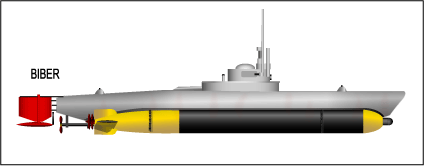
The “Castor” were created from a submersible captured in Norway on Nov. 22, 1943, the Welman W46, which was then trying to blow up the doors of the dry docks of Bergen. This type of single-seater, two-tonne British submersible was produced at more than 100 units and did not have a periscope or torpedoes. They simply had to approach his target and deliver his explosive head of 540 kg. Replicated satisfactorily from 1944, the Biber was the second German pocket submersible in use. Unlike the relatively poor English model, the Biber had two standard 533 mm torpedoes and a periscope, was capable of spinning 6 knots on the surface and traveling 130 nautical miles. It was the Flenderwerke shipyards in Lübeck which were responsible for its production series, starting in May 1944, after a prototype in March, and 24 of pre-production in April.
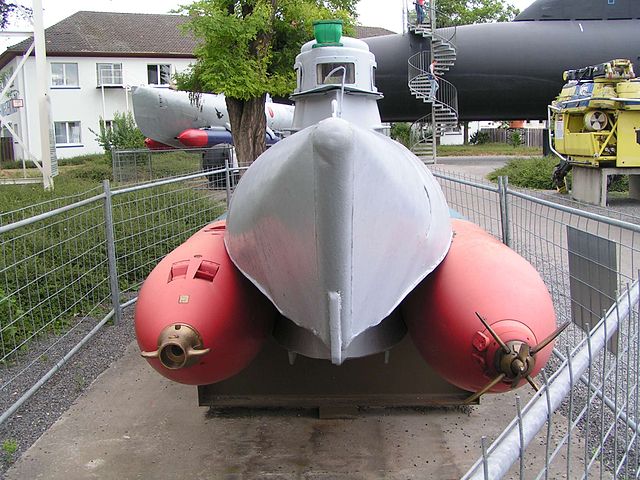
Biber at the Technik Museum Speyer in Germany, rear view.
A total of 324 units were produced, the last in December 1944. The massive raids on Lübeck and the surrounding area disrupted production, as the Biber was pre-assembled into three sections merely joined together. The operational career of the Biber was not to be significant: Apart from the cargo ship Alan A. Dale, sent by the bottom in 1944, the tonnage sunk was only 4910 tons. The Biber never worried about the allied lines of communication, particularly at the level of the landing craft. As for the Biber II and III future two-seaters, they never past the the drawing board stage.
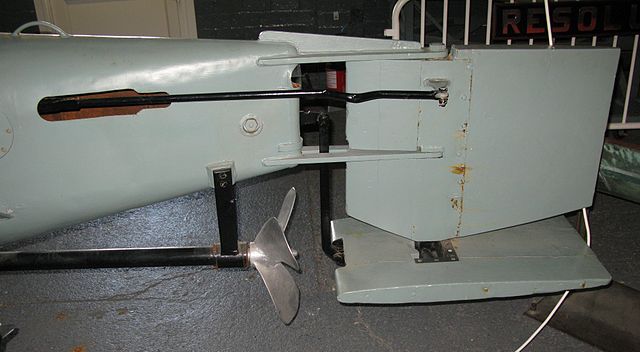
Biber’s control surfaces
Specs
-Dimensions 10,4 x 1,6 m
-Weight 6,3 tonnes
-Prop. 1 Opel Blitz 32 hp, 13 hp electric generator, 6,5/5,3 kn surface/sub
-Armament 2 G7e torpedoes 533 mm (21 in)
-Crew 1
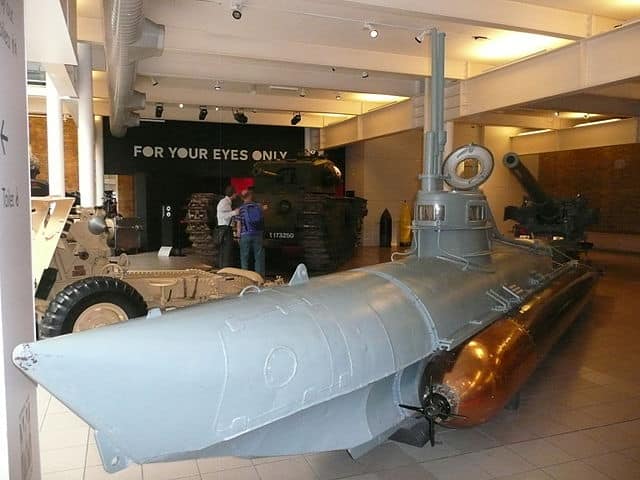
Bieber exhibited at the Imperial War Museum
Hecht:
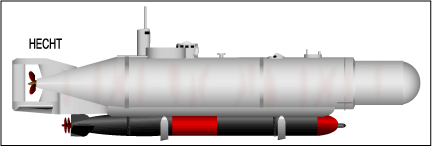
These “pikes” were designed to deposit a time-lag explosive charge on the flank of a ship at anchor, a role entrusted by the British to their units of the Welman and X type, and dating back to the Fulton and Bushnell experiments in the eighteenth century. This kind of “mission-suicide” remains eminently random. In fact, these triple-shell units with cylindrical hulls, the front part of which (a 1000 kg suction cup) was detached, were practically never used in this role, any more than those carrying magnetic mines. They were therefore grafted two torpedoes, but in general these units were considered mediocre.
Their range was limited to 78 miles and their speed to 3 knots, or 6 submerged, with 40 miles in diving. Built at Germaniawerft in Kiel from May 1944, 53 units were created (numbered as U-2111, 2112 and 2113, and U2251-2300). Finally they were used for the training of the Seehund and Biber crews.
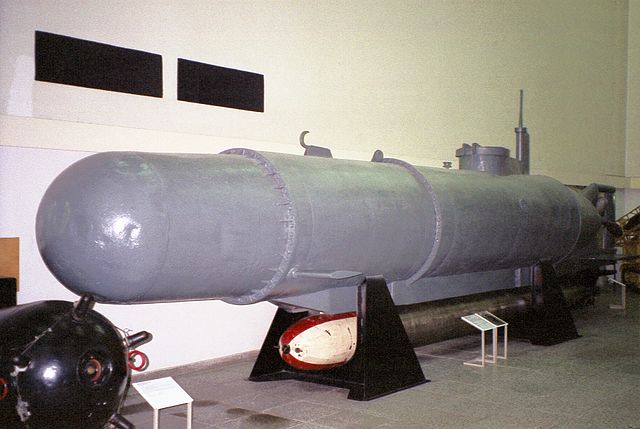
Hecht type at Dresden.
Specs
-Dimensions: 10,5 x 1,7 m
-Weight: 12,5 tonnes
-Propulsion: 1 Electric motor 13 hp, 5,6/6 knots surface/sub
-Armament: 2x G7e 533 mm torpedoes (21 in), or a mine
-Crew: 2
Seehund (Type XXVII)
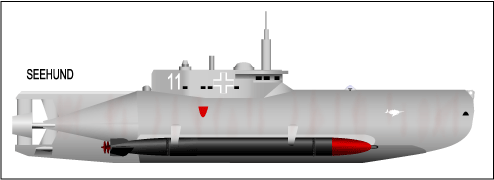
Literally “sea dogs” these were the last, largest and best pocket submersibles built by Nazi Germany. While 138 units were eventually taken into account by the Kriegsmarine, an initial series of 1,000 units was planned, all in service for January 1945.
This production began in September 1944 and ended in April 1945. With a solid hull welded by sections, Equipment simplified and automated to the extreme, it was even considered to be given to the Hitler youth. This was not the case because their handling required weeks of practice for every sailor.
They carried two standard G7a torpedoes 533 mm (21 in), dived at 38 meters, surfaced at 7 knots even with a force-formed sea on the Beaufort scale. However the simple relief when launching their torpedoes required a stationary position during firing.
Two-seaters, designed as true submersibles with mixed propulsion, they should in principle successfully support the XXI and XXIII series, although limited to operations from the coast. Some 50 units in 1945 obtained a substantial extension of their oil tank, their autonomy rising to 300 nautical miles (550 km).
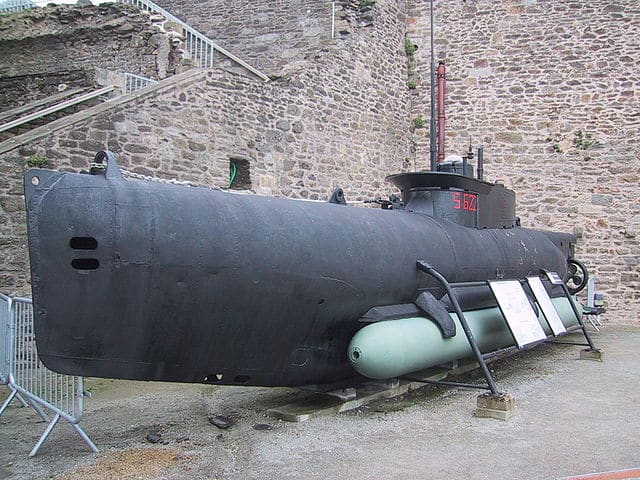
In the end, these units sank 8 allied ships for a total of 17,300 tons and damaged three others. It was the best performances of German mini-subs so far, for 142 sorties and 32 losses. They operated for the first time from the Banks of Holland on December 31, 1944, and throughout January.
Kwinte’s raid on an allied convoy resulted in the loss of 16 units out of the 17 sent, most of which ran aground on sandbanks, others sunk by the RN, and others lost in heavy weather. The other raids were hardly happier.
In February 1945 (and as of late January), the units attempted to obstruct maritime traffic on the south-eastern coast of England, particularly in the Ramsgate area. Operations continued with a bit more success in March (3 sunken ships), while units based in Ijmuiden in Norway practically did not made any outings due to the heavy weather.
The latter operated in the Danish Strait in April 1945. On the 28th, all exits were canceled. Most of the losses were due to poor weather conditions and the lack of experience of their operators. Many Seehunds have been captured or recovered, and are nowadays museum pieces. See in 3D HD (sketchfab)
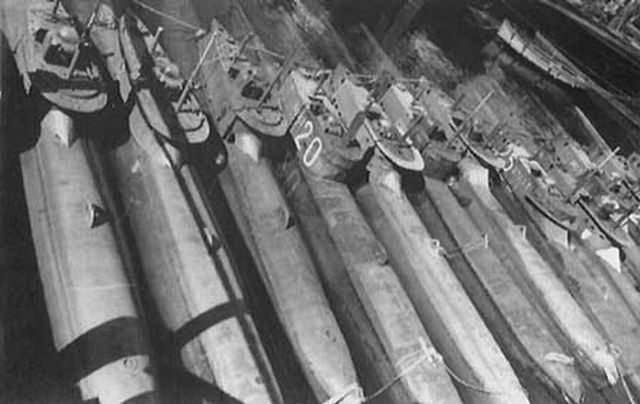
Specs
-Dimensions 10,9 x 1,7 m
-Weight 14,9 tonnes
-Prop. 1x Büssing diesel 60 hp, 1x Electrical engine 25 hp, 6,5 to 5,3 knots surface/sub
-Armement: 2 G7e 533 mm (21 in) torpedoes.
-Crew 2
Human torpedoes:
Three types were tested during the war, and two series became operational. Overall, the concept of “torpedo carrier” was reduced to its simplest expression since the torpedo was launched from another torpedo summarily arranged to allow a basic piloting. They were not, however, genuine “suicide torpedoes” such as those used by the Japanese and in which the operator was directing the torpedo itself until explosion. Nevertheless, this type of arrangement, although very economical to produce in mass, proved practically unfit for service due to a far too small radius of action. The “cockpit” was submerged to allow pressure balancing, and the pilot was helmeted, equipped with a breathing apparatus borrowed from the Luftwaffe and a frogman suit. He launched his torpedo after monitoring summary graduations on the hood, but no navigation marks nor speed calculator (For moving ships).
Neger:

The neger (“nigger”) was perhaps an extrapolation of the name of its inventor, Richard Mohr (“Moorish” in German, who headed the engineering firm Kleinkampfverbände). Moreover, these torpedoes were invariably black, for mostly nocturnal operations. This was the first type of steered torpedo. The first was operational in March 1944 and 200 were to follow. Equipped with an electric motor, the neger could sail at 3.7 to 4 knots over 48 nautical miles (88 km). At worst, given the rudimentary and economic nature of the craft, its pilot could bring it within range and then evacuate it once the batteries were empty, swimming for safety.
The pilot had a (relative) good vision thanks to a plexiglass bubble. Nevertheless, the respirator mask provoked several deaths by asphyxiation. The other big black dot was the inability of these units to dive. Their cockpit bubble, though small, was still very visible even at night, and in heavy weather this kind of craft was simply not maneuverable. In spite of these limitations, volunteers were recruited for missions intended to carry severe blows to the landing fleet.
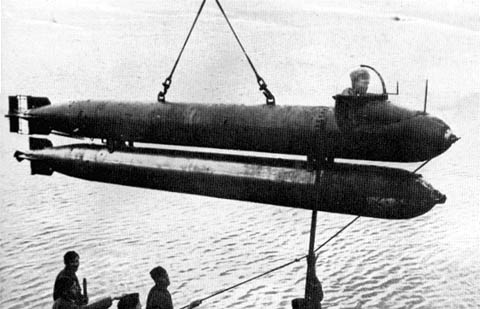
The first intervention took place in front of Anzio, on April 20, 1944, 30 units were to attack the north of the bridgehead from Torre Vaianica. It was a total failure, only 17 were launched, losing their way en route, the commander of the squadron perishing from the beginning of the operation of a CO2 intoxication. Three units were lost, all the others ran aground and were captured. The second implementation began in June 1944, in the night of 5 to 6, from Villers-sur-mer in the Bay of Seine and north of Honfleur. This time the 26 units arrived in sight of their objectives in spite of the detestable weather, and sank three minesweepers (HMS Cato, Magic and Pylades) and several small transports, and from June 7 to 8 the best success was to damage The Polish Dragon cruiser, which was deemed unfit for service and was subsequently submerged as a breakwater of the artificial harbor, which earned medals for two of these pilots. Others gave up without having seen the objective.
Specs
-Dimensions: 8 x 0,53 m
-Weight: 2,7 tonnes
-Propulsion: 1 Elect. mot. 12 hp, 4,2/3,2 knots surface/sub
-Armament: 1 G7e torpedo 533 mm (21 in)
-Crew: 1
Marder

The Marder was simply an extrapolation of the Neger. Unlike the first, limited to the surface, the Marder could dive to 40 meters. This allowed her to escape a potential “predator” or in case of very bad weather. 500 units were produced, until May 1945. Again, equipments were reduced to the bare minimum, only a few graduations on the cockpit and a stem at the front of the nose which allowed to aim the enemy ship. Stress on board was considerable and many losses were due to physical exhaustion, despair, utter claustrophobia, carbon dioxide poisoning, or simply execrable weather (most volunteers were not even sailors).
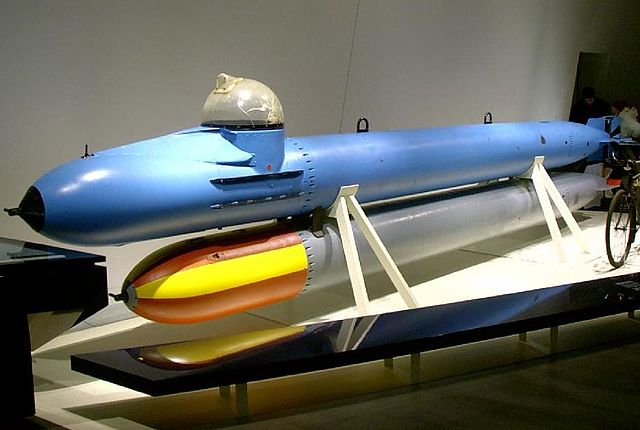
Marder at the Bundeswehr Museum
Their first sortie was attempted on the night of August 2-4, 1944 from Houlgate, and Marders sank the escort destroyer HMS Quail, a minesweeper, an LST, a liberty-ship and another 7,000-ton transport, and damaged one cruiser. However, the Allied counter-attack was vigorous and only 17 units returned to port. This loss rate – which was not going to improve later – would quickly make these units, which were supposed to return to their base after the action, real one-ticket “coffins”, and volunteers quickly rarefied. Another action was attempted on 16-17 August, 42 Marders attacking the old French battleship Courbet (two hits with no great consequences), and the small balloon-boat HMS Fratton and a transport were also sunk. 26 Marder were lost during this attack. Finally in September 1944 another “K-Verbänd” of 30 units attacked the allied landing fleet in Italy. No victory was recorded and at the same time 17 units were lost at sea, the others who had survived the mission and hoisted dry were destroyed by a coastal bombardment at Vertimiglia.
Specs
-Dimensions: 8,30 x 0,53 m
-Weight: 3 tonnes
-Propulsion: 1 Elect.motor, 12 hp, 4,2/3,2 knots surface/sub
-Armement: 1 G7e 533 mm torpedo
-Crew: 1

Hai prototype schematics
Hai
The “shark” was a very improved model of the Marder, sometimes called “super-Marder”. Enlarged, and with bigger batteries, for a top speed of 20 knots in the final attack phase. Longer from 2.40 m, they also offered a radius of action of 78 km at 3 knots. However, its long development due to numerous technical problems resulted in the cancellation of the program in April 1945, which ended with just three prototypes.
other German pocket subs Projects
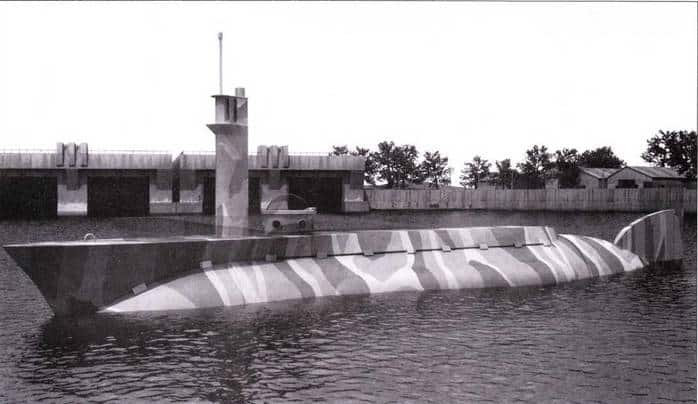
The Seeteufel was an interesting submarine tank, perhaps the only one of its kind built in ww2.
Delphin
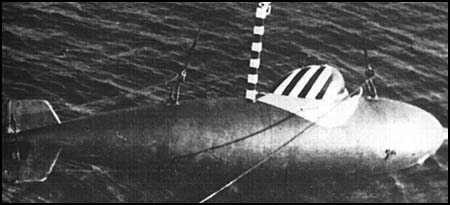
Experimental Delphin midget sub
Three prototypes of the Dauphin were produced. It was a derivative of the Marder, but with a specially designed hull and a bigger battery. He had to be able to sail at 17 knots at the time of the attack. The three prototypes were lost after the testing began in January 1945.
Seeteufel
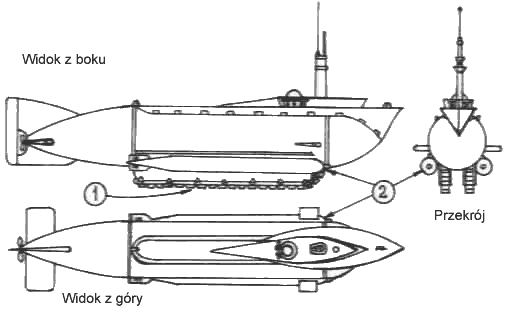
Blueprint of the Seeteufel
The “seas devils” were an interesting concept of “submersible tank” inspired among others special versions of Italian tracked MAS like the Grillo in 1917-18. Basically this was an amphibious unit capable of moving on the sea bottom to its objective before launching its two torpedoes. Two-seater, weighing 35 tons, 14.2 meters long, it was one of the most fantastic German submarine projects. The only prototype was deliberately destroyed in its test field near Lübeck at the time of the German surrender. A longer article will be done in collaboration with Tank Encyclopedia.
Schwertval
The “Orca” (or Grampus) also officially known as SW1 was a prototype of a fast mini-submersible equipped with a Walter turbine. It was on paper capable to sail 30 knots not only during its approach phase but cruising all the way while being submerged. The prototype made only rare attempts (known to be the problems of these revolutionary turbines) in Plöner’s seawater trial area before being scuttled in May 1945. British engineers sought it out and bailed it out for detailed study after the war.
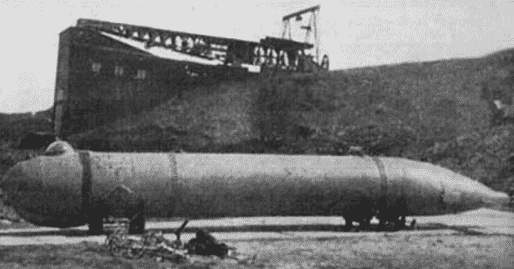
Schwertval
V80
There was also the V.80, a four man, 76-ton prototype completed in 1940 to test Walther geared turbine propulsion system. Her Range was 50 nautical miles at 28 knots. A serie named “Orca” were also built postwar. The midget submarines were swimmer delivery vehicle, for covert operations. Another cold war type called Narwal was also used until the Berlin wall fall.
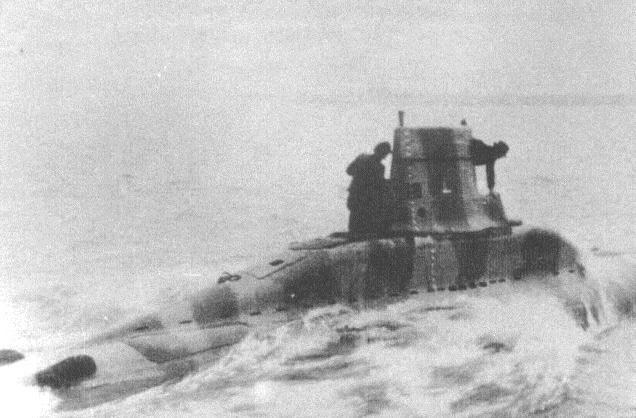
V80 experimental midget sub, notice the camouflage
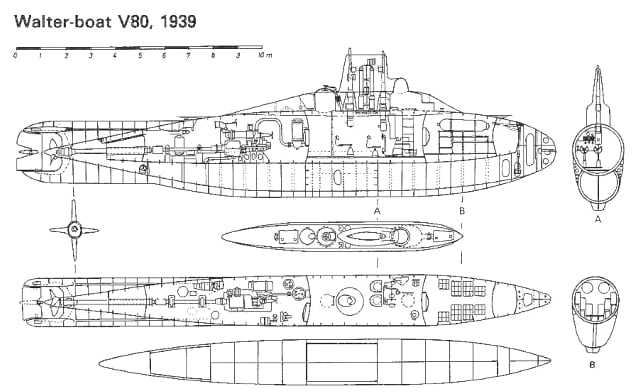
Blueprint of the V80
Sources and links
https://en.wikipedia.org/wiki/Biber_(submarine)
https://en.wikipedia.org/wiki/Midget_submarine
http://www.eurekaencyclopedia.com/index.php/Category:Midget_Submarines



 Latest Facebook Entry -
Latest Facebook Entry -  X(Tweeter) Naval Encyclopedia's deck archive
X(Tweeter) Naval Encyclopedia's deck archive Instagram (@navalencyc)
Instagram (@navalencyc)





 French Navy
French Navy Royal Navy
Royal Navy Russian Navy
Russian Navy Armada Espanola
Armada Espanola Austrian Navy
Austrian Navy K.u.K. Kriegsmarine
K.u.K. Kriegsmarine Dansk Marine
Dansk Marine Nautiko Hellenon
Nautiko Hellenon Koninklije Marine 1870
Koninklije Marine 1870 Marinha do Brasil
Marinha do Brasil Osmanlı Donanması
Osmanlı Donanması Marina Do Peru
Marina Do Peru Marinha do Portugal
Marinha do Portugal Regia Marina 1870
Regia Marina 1870 Nihhon Kaigun 1870
Nihhon Kaigun 1870 Preußische Marine 1870
Preußische Marine 1870 Russkiy Flot 1870
Russkiy Flot 1870 Svenska marinen
Svenska marinen Søværnet
Søværnet Union Navy
Union Navy Confederate Navy
Confederate Navy Armada de Argentina
Armada de Argentina Imperial Chinese Navy
Imperial Chinese Navy Marinha do Portugal
Marinha do Portugal Mexico
Mexico Kaiserliche Marine
Kaiserliche Marine 1898 US Navy
1898 US Navy Sovietskiy Flot
Sovietskiy Flot Royal Canadian Navy
Royal Canadian Navy Royal Australian Navy
Royal Australian Navy RNZN Fleet
RNZN Fleet Chinese Navy 1937
Chinese Navy 1937 Kriegsmarine
Kriegsmarine Chilean Navy
Chilean Navy Danish Navy
Danish Navy Finnish Navy
Finnish Navy Hellenic Navy
Hellenic Navy Polish Navy
Polish Navy Romanian Navy
Romanian Navy Turkish Navy
Turkish Navy Royal Yugoslav Navy
Royal Yugoslav Navy Royal Thai Navy
Royal Thai Navy Minor Navies
Minor Navies Albania
Albania Austria
Austria Belgium
Belgium Columbia
Columbia Costa Rica
Costa Rica Cuba
Cuba Czechoslovakia
Czechoslovakia Dominican Republic
Dominican Republic Haiti
Haiti Hungary
Hungary Honduras
Honduras Estonia
Estonia Iceland
Iceland Eire
Eire Equador
Equador Iran
Iran Iraq
Iraq Latvia
Latvia Liberia
Liberia Lithuania
Lithuania Mandchukuo
Mandchukuo Morocco
Morocco Nicaragua
Nicaragua Persia
Persia San Salvador
San Salvador Sarawak
Sarawak Uruguay
Uruguay Venezuela
Venezuela Zanzibar
Zanzibar Warsaw Pact Navies
Warsaw Pact Navies Bulgaria
Bulgaria Hungary
Hungary

 Bundesmarine
Bundesmarine Dutch Navy
Dutch Navy Hellenic Navy
Hellenic Navy Marina Militare
Marina Militare Yugoslav Navy
Yugoslav Navy Chinese Navy
Chinese Navy Indian Navy
Indian Navy Indonesian Navy
Indonesian Navy JMSDF
JMSDF North Korean Navy
North Korean Navy Pakistani Navy
Pakistani Navy Philippines Navy
Philippines Navy ROKN
ROKN Rep. of Singapore Navy
Rep. of Singapore Navy Taiwanese Navy
Taiwanese Navy IDF Navy
IDF Navy Saudi Navy
Saudi Navy Royal New Zealand Navy
Royal New Zealand Navy Egyptian Navy
Egyptian Navy South African Navy
South African Navy






























 Ukrainian Navy
Ukrainian Navy dbodesign
dbodesign